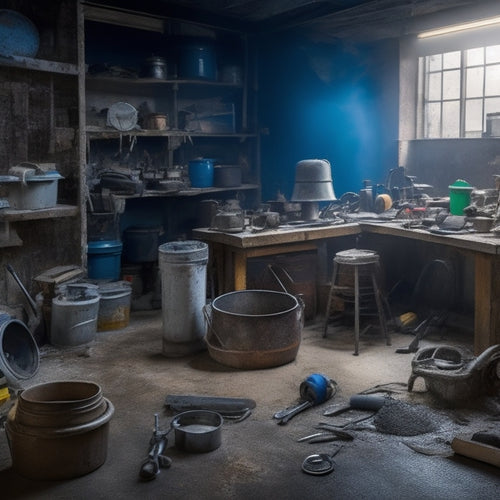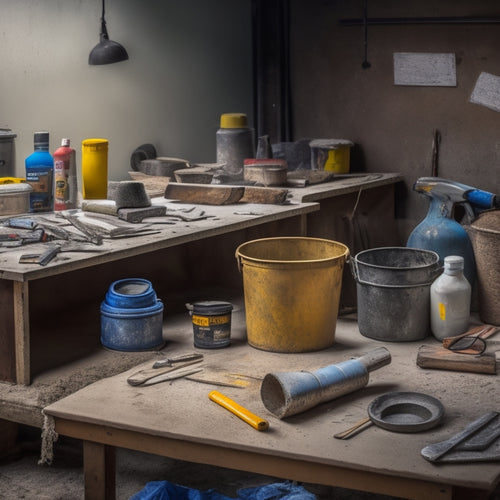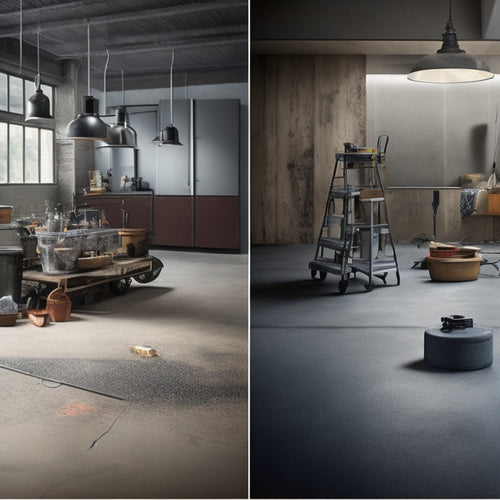
Why You Need These Concrete Repair Tools First
Share
When tackling concrete repairs, you need the right tools from the start to achieve long-lasting results. Foundation crack injection tools, such as high-pressure injection pumps and packer/injection ports, guarantee precise control over material flow. Surface preparation equipment, including scabblers and grinders, is crucial for creating a smooth, debris-free surface. You'll also need specialized drill bits and advanced epoxy injection systems to assure strong bonding. With the correct tools, you can select the ideal concrete patching material for your specific repair, whether it's acrylic-based compounds or epoxy-based compounds. By learning more about these essential tools, you'll be well-equipped to take on complex repairs and achieve a durable fix.
Key Takeaways
• Proper surface preparation with specialized equipment ensures a strong bond between old and new concrete for lasting repairs.
• Advanced epoxy injection systems with precise pressure control and adjustable flow rates guarantee effective delivery and strong bonding.
• Specialized drill bits and accessories, such as carbide-tipped and diamond-coated drill bits, enhance capability for tough concrete repair tasks.
• Foundation crack injection tools, including high-pressure pumps and hose assemblies, enable accurate control of material flow for successful repairs.
• Choosing the right concrete patching material, such as acrylic- or epoxy-based compounds, ensures a durable fix that restores strength and integrity.
Foundation Crack Injection Tools
When injecting polyurethane or epoxy resin into foundation cracks, you'll need a set of specialized tools designed to guarantee a successful and long-lasting repair. These tools are essential for effective foundation repair techniques, assuring that crack sealing methods are executed with precision.
You'll require a high-pressure injection pump, capable of delivering the necessary force to fill even the smallest cracks. A packer or injection port is also necessary, allowing you to inject the resin or polyurethane directly into the crack.
Additionally, a suitable hose and gun assembly will enable you to accurately control the flow of material. For more complex repairs, a static mixer or cartridge gun may be required to ensure proper mixing and application.
Surface Preparation Equipment Essentials
You'll need to confirm the surface is properly prepared before applying any repair materials, which is where surface preparation equipment comes in, playing an essential role in achieving a strong bond between the old and new concrete.
This step is vital, as it guarantees a strong and durable repair. Without proper surface preparation, the new concrete may not adhere correctly, leading to a weak and short-lived repair.
To achieve a strong bond, you'll need the right surface preparation equipment. Here are the essentials:
-
Scabblers: These tools are used to roughen the surface, creating a texture that allows the new concrete to bond better. Scabblers come in various sizes and types, including handheld and walk-behind models.
-
Grinders: Grinders are used to smooth out the surface, removing any imperfections or old coatings. They're essential for creating a uniform surface that's ready for repair.
-
Vacuum cleaners: Surface cleaning is vital, and vacuum cleaners are used to remove any debris or dust that may interfere with the bonding process.
Concrete Patching Material Options
With the surface properly prepared, it's time to select a suitable concrete patching material that meets the specific requirements of your repair job.
You'll need to take into account factors like the size and depth of the repair, the type of concrete, and the environmental conditions. There are various patching compounds to choose from, each with its own strengths and weaknesses.
Acrylic-based compounds are ideal for small, shallow repairs, while epoxy-based compounds are better suited for larger, deeper repairs that require high strength and durability.
When selecting a patching material, you'll also need to take into account the repair techniques you'll be using. Will you be doing a vertical or horizontal repair? Do you need a material that can be troweled, poured, or injected?
Understanding the specific demands of your repair job will help you choose the right material and guarantee a successful outcome. By selecting the right patching compound and employing the correct repair techniques, you'll be able to restore your concrete surface to its original strength and integrity.
Advanced Epoxy Injection Systems
Selecting the right patching compound is only half the battle; now it's time to employ advanced epoxy injection systems that can effectively deliver the patching material to the damaged area, guaranteeing a strong and lasting repair. You need a system that can accurately inject the epoxy into the crack or void, allowing for ideal epoxy bonding and a durable fix.
Here are three key considerations for advanced epoxy injection systems:
-
Pressure Control: You need a system that allows for precise pressure control to guarantee the epoxy is injected at the right rate, preventing overflow or underfilling.
-
Injection Guns: A high-quality injection gun is essential for delivering the epoxy to the damaged area. Look for guns with adjustable flow rates and high-pressure capabilities.
-
Porting Systems: A well-designed porting system enables you to inject the epoxy at multiple points, allowing for a more thorough repair.
Specialized Drill Bits and Accessories
Three specialized drill bits are essential to your concrete repair toolkit: a carbide-tipped drill bit for making precise holes, a diamond-coated core drill bit for coring through thick concrete, and a masonry drill bit for general-purpose drilling. These bits will help you tackle a wide range of concrete repair tasks with ease and precision.
| Drill Bit Type | Application | Benefits |
|---|---|---|
| Carbide-tipped | Precise hole-making | Fast drilling, long-lasting |
| Diamond-coated core | Coring through thick concrete | Fast coring, accurate holes |
| Masonry drill | General-purpose drilling | Versatile, cost-effective |
When choosing a diamond-coated core drill bit, consider the thickness of the concrete you'll be working with. For thicker concrete, you'll need a bit with a larger diameter and more aggressive diamond coating. For general-purpose drilling, a masonry drill bit is a great all-around choice. With these specialized drill bits in your toolkit, you'll be equipped to handle even the toughest concrete repair tasks.
Frequently Asked Questions
Can I Use Concrete Repair Tools for DIY Home Renovation Projects?
When tackling a DIY home renovation project, you're likely wondering if concrete repair tools are suitable for the job.
The answer is yes! With the right tools, you can master various concrete repair techniques, ensuring a professional finish.
How Often Should I Clean and Maintain My Concrete Repair Tools?
When you're not using your concrete repair tools, you're storing them, and that's where tool storage comes in.
You should establish a maintenance schedule to make sure your tools remain in prime condition. Clean your tools after each use, and perform a deep clean every month.
Check for worn or damaged parts, and replace them as needed. Regular maintenance will extend the lifespan of your tools and assure peak performance for your DIY home renovation projects.
Are Concrete Repair Tools Suitable for All Types of Concrete Surfaces?
Fasten your seatbelt, because we're about to plunge into the world of concrete repair tools!
Are they suitable for all types of concrete surfaces? The answer is, it depends. You see, not all concrete surface types are created equal, and neither are repair tools.
Compatibility is key. For instance, epoxy-based tools work wonders on high-traffic areas, while polyurethane-based tools are better suited for decorative concrete.
You'll need to choose the right tool for the job to guarantee a durable, long-lasting repair.
Can I Rent Concrete Repair Tools Instead of Buying Them?
You're considering renting concrete repair tools instead of buying them. That's a smart move.
You'll benefit from tool rental advantages like reduced upfront costs and minimal storage needs.
Compare the costs: rental fees versus purchasing and maintaining equipment.
Crunch the numbers and you'll see that renting might be the way to go, especially for infrequent or one-time projects.
Do I Need Special Training to Use Concrete Repair Tools Safely?
You'll need to guarantee you're properly trained to use concrete repair tools safely and effectively.
Familiarize yourself with safety guidelines and best practices for tool selection, operation, and maintenance. You can't afford to compromise your safety or the integrity of the repair.
Take the time to learn about the tools, their applications, and potential hazards to avoid costly mistakes and guarantee a successful repair.
Conclusion
As you gear up for your concrete repair project, remember that having the right tools is like holding the keys to a fortress - it's the difference between a sturdy stronghold and a crumbling castle.
Don't let cracks and damage get the best of you; with these essential concrete repair tools, you'll be well-equipped to tackle even the toughest projects and emerge victorious.
Related Posts
-

7 Tools to Fix Damaged Concrete Floors
You're about to tackle that damaged concrete floor, and the right tools are essential for a successful repair. Start ...
-

3 Best Tools to Buy for Concrete Repair Online
When buying tools for concrete repair online, you'll want to research multiple retailer options to find the best prod...
-

Top Tools for Revamping Old Concrete Floors
You'll need a range of tools to revamp your old concrete floor, starting with epoxy, acrylic, or polyurethane paint, ...


